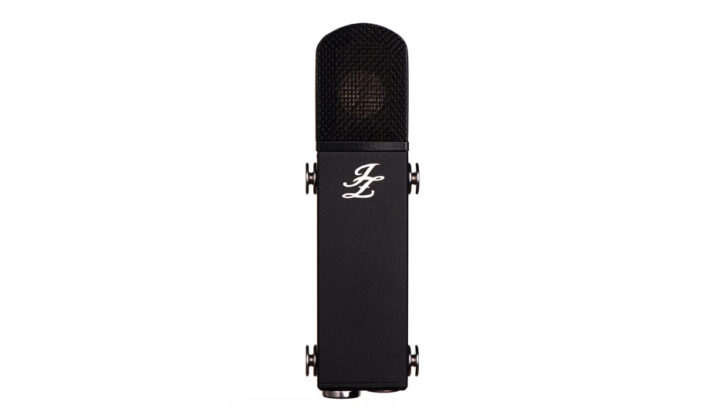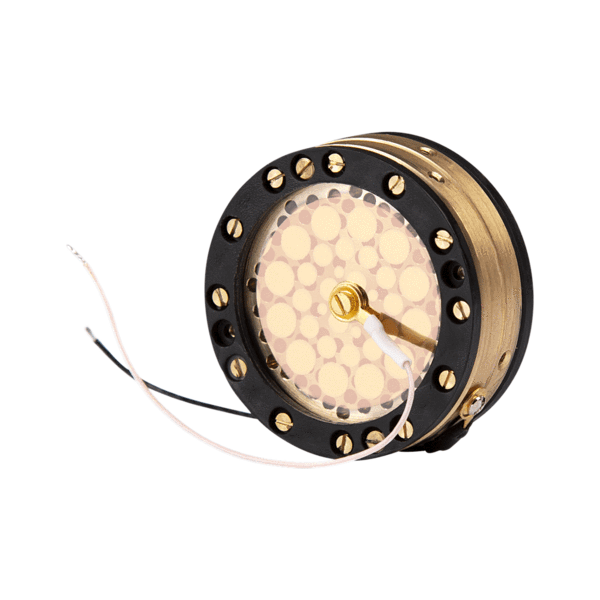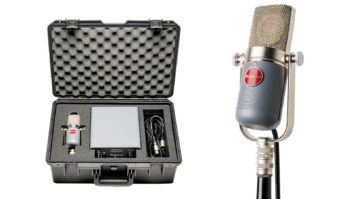
I’ve been a fan of JZ mics for some time now, having reviewed their Amethyst, Black Hole, Vintage series (V47, 67, 11, 12) and their small-diaphragm BT201s too, all with more than satisfactory results, all with plenty of color (except for the neutral Black Hole) and all with plenty of design style. The new BB29 from the JZ Signature Series looks to combine the overall structure of the Black Hole with the personality of the Vintage series, except sporting an output transformer—a first for JZ.
Out of the Box

The BB29 is a single-diaphragm pressure-gradient condenser microphone, utilizing JZ’s patented Golden Drop diaphragm-coating technology on a 1” membrane, with a Class-A discrete hand-built circuit. The mic is shaped like a rectangular cartridge, with a flat/squarish head basket—very much like the Black Hole except the hole area is solid. An elastic suspension shock mount ($99) grabs the BB29 via four grommets, holding the mic firmly and allowing close placement to things like speaker cabinet grills.
The provided frequency response graph shows 20 to 20k response, with a little 500 Hz bump and a gradual presence rise punctuated with a high-end boost of five dB that’s not rolling off until 15k. Output impedance is 150 ohms (1000 ohm ideal load), with a max SPL handling of 140 dB and A-rated self-noise of only 9 dB. There are no pads or switches on the cardioid-only mic, which carries a substantial five-year warranty, for $1,299 direct.
In Session
Being familiar with JZ mics, I threw the BB29 right in there as a third drum kit overhead, a “lower-head” about two feet off the floor and six feet out, via Manley TNT preamp, hoping to get a fairly balanced middle-of-the-kit image with plenty of cymbal; that’s exactly what I got. I could hear the room “air,” got largely uncompressed dynamics and a nice (mono) hi-fi picture.
The next day, I put the BB29 up there with two other mics in order to pick two favorites for a super-powerful alto female vocalist tracking a full-length. With amplification from an Avalon VT737 channel, my singer didn’t prefer the BB29 (I think the high-end emphasis bothered her), so I rolled off some top and thinned out the very-bottom, and we used it for most of the backing vocals.
Next, I had a drum session with a fairly light-handed drummer where my close mics and room ribbon needed some help in both punch and excitement. I placed the BB29 much like I did the first time but amped it up with an SSL VHD preamp and dialed in moderate levels of 2nd and 3rd order harmonics, followed by compression via ART VLA-modified with low-end enhancing Carnhill transformers. The result was a much bigger-than-life sound with gutsy punch, a fancy sheen and more raw power than my overheads or room ribbon.
I often use a JZ V12 on electric guitar, where its C12-like qualities make for one nicely articulated guitar sound, so I just had to compare the BB29 directly with a pair of AMS-Neve 4081 mic preamps which are super consistent and rather neutral. I jumped around various tones, but long story short, the BB29 seemed to have a little more up top, had flatter mids than the sculpted V12 and a little more bottom. Definitely a bright sound overall, but really nice and no trouble at all with SPL, even though the BB29 doesn’t have a pad.
Apple Audio Unit Plug-Ins — A Real-World Review
I got good results with tambourine, shaker and handclaps with the BB29, too, even if the resulting tone was more crisp than full. The high-end emphasis was substantial but not overbearing, and the high-frequencies were clean, not at all distorted or crunchy.
Acoustic guitar—amped up with a Cranborne Audio Camden 500, chosen for a lack of color and consistent linearity—found the BB29 putting out a well-balanced picture if going a little heavy on very high-end, but in a way that most of you might just prefer (depends on the exact situation really). My Yamaha upright piano didn’t play well with the BB29 though, as the hammers hitting the strings created prominent clicks that just weren’t musical, lid open or closed. My personal vocal tests were revealing, too; the off-axis response was forgiving enough to allow a little roll to the side to ease off that very-high-end definition bump (I’d like to try that with the alto vocalist now) and the proximity effect was audible at 5”, substantial at 3” to 4” out and a bit overbearing any closer than that.
The Final Mix
All in all, the BB29 is another high-quality, colorful and high-fidelity mic from JZ; it looks like the company’s Black Hole, sounds more like the Vintage series but with the extra emphasis both down-low and up-high from a transformer (with a touch of low-end saturation, too). Oddly enough, my most universal comparison would be a bright vintage U67 in cardioid (they all sound a little different it seems), with ample midrange (that little 500 Hz bump?) and sculpted euphony at each end of the spectrum. As with most colorful offerings, the BB29 won’t be a perfect fit for everything and its simplicity limits the range of applications, but when it does fit, you’ll find it exceptional.
JZ Microphones • www.jzmic.com







